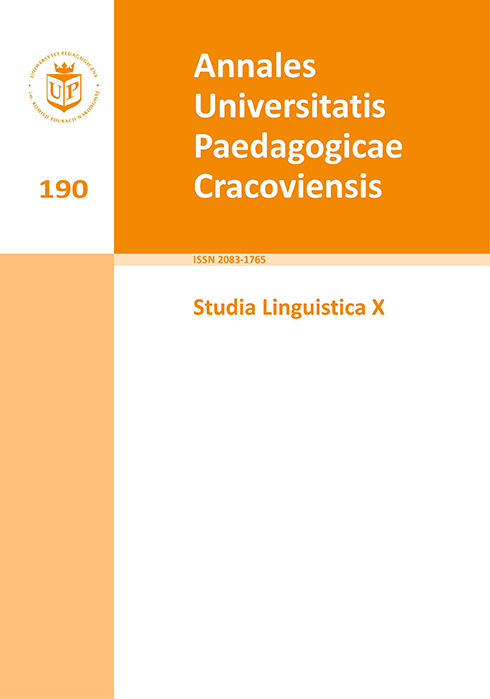Językowo-kulturowy obraz łyka w świetle dawnych frazeologizmów i przysłów
Main Article Content
Abstract
The article deals with phraseologisms and proverbs which contain the component łyko (phloem). The analysis of collected material made it possible to reconstruct the linguistic view of old reality connected with low material status of country dwellers and their abil- ity to cope with the difficulties of daily life. Due to the change of reality the discussed units now constitute an archaic part of Polish phraseological and paremiological resources.
Downloads
Article Details
Author, submitting a text to the editorial board of the journal “Annales Universitatis Paedagogicae Cracoviensis. Studia Linguistica", certifies that the content of the article has not been published so far and that the work does not violate in any way the copyright or related rights of other person, as well as other rights of third parties, and that no one's rights to the work (or any part thereof) have been missed. After signing the contract, the property rights to the published materials are transferred to the Scientific Publisher of the University of the National Education Commission, Krakow.
“Annales Universitatis Paedagogicae Cracoviensis. Studia Linguistica” is an open access journal, and all its content is made available free of charge to users and institutions under the Creative Commons CC-BY-NC-ND 4.0 license (attribution, non-commercial use, no derivative works). Under this license, the authors agree that their work may be lawfully reused for any purpose, except for commercial purposes, without the prior consent of the author or publisher. Everyone can read, download, copy, print, distribute and process these works, provided that the author's marking and the original publication place are correct. Published texts may not be used to create derivative works (e.g. to translate and publish in another language without the consent of the publisher). This is in line with the BOAI (Budapest Open Access Initiative) definition. "Studia Linguistica" does not charge for submitting or processing articles.
References
Bartmiński J., 2006, Językowe podstawy obrazu świata, Lublin.
Google Scholar
Biernacka M., Kopczyńska-Jaworska B., Kutrzeba-Pojnarowa A., Paprocka W. (red.), 1976, Etnografia Polski. Przemiany kultury ludowej, t. I, Wrocław – Warszawa – Kraków – Gdańsk.
Google Scholar
Buttler D., 1989, Dlaczego zanikają przysłowia w dwudziestowiecznej polszczyźnie?, „Poradnik Językowy”, z. 5, s. 332–337.
Google Scholar
Bystroń J.S., 1933, Przysłowia polskie, Kraków.
Google Scholar
Chlebda W., 2001, Frazeologia polska minionego wieku, [w:] Polszczyzna XX wieku. Ewolucja i perspektywy rozwoju, red. S. Dubisz, S. Gajda, Warszawa, s. 155–165.
Google Scholar
Cygan S., 2007, Słownictwo pism Stefana Żeromskiego, t. 9: Świat roślin, Kraków.
Google Scholar
Czachorowska M., 2012, Świat roślin w pismach Bolesława Prusa, Bydgoszcz.
Google Scholar
Jacher-Tyszkowa A., 1977, Atlas strojów ludowych, t. V, z. 12: Strój kielecki, Wrocław.
Google Scholar
Kolberg O., 1875, Dzieła wszystkie, t. IX: W. Ks. Poznańskie, cz. 1, Kraków.
Google Scholar
Malec M., 1998, Etnonimy. Nazwy narodowości. Nazwy mieszkańców, [w:] Polskie nazwy własne. Encyklopedia, red. E. Rzetelska-Feleszko, Warszawa – Kraków, s. 180–188.
Google Scholar
Młynarczyk E., 2013, Nie święci garnki lepią. Obraz rzemiosła utrwalony w polskiej frazeologii, Kraków.
Google Scholar
Nowakowska A., 2005, Świat roślin w polskiej frazeologii, Wrocław.
Google Scholar
Skuza Z.A., 2006, Ginące zawody w Polsce, Warszawa.
Google Scholar

